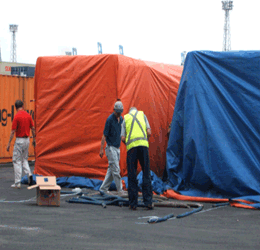
Fumigation

Fumigation:
Methyl Bromide and Aluminium Phosphide (phosphine) gas is used to provide quarantine and pre-shipment fumigation of export commodities in bulk, liner, chartered vessels and sea-going containers at all ports and Inland Container Depots (ICDs)
Why Fumigation?
Commodities such as food grains, cotton, oilseeds, pulses, extractions, spices, tobacco, textile, timber etc., which are major items in today's export market, are highly susceptible to infestation from stored grain pests during storage and transit. This infestation can cause extensive damage. Also, the strict quarantine and regulatory requirements of various nations mandate a pest-free shipment. Fumigation (or the use of a gas in an enclosed space to kill pests) as a curative control technique is an indispensable requirement; lethal to all stages of insect development - eggs, larvae, pupa and adult, it not only kills live infestations, but also helps to check the spread of unwanted pests from one country to another.
Methyl Bromide and Aluminium Phosphide (phosphine) gas is used to provide quarantine and pre-shipment fumigation of export commodities in bulk, liner, chartered vessels and sea-going containers at all ports and Inland Container Depots (ICDs)
Why Fumigation?
Commodities such as food grains, cotton, oilseeds, pulses, extractions, spices, tobacco, textile, timber etc., which are major items in today's export market, are highly susceptible to infestation from stored grain pests during storage and transit. This infestation can cause extensive damage. Also, the strict quarantine and regulatory requirements of various nations mandate a pest-free shipment. Fumigation (or the use of a gas in an enclosed space to kill pests) as a curative control technique is an indispensable requirement; lethal to all stages of insect development - eggs, larvae, pupa and adult, it not only kills live infestations, but also helps to check the spread of unwanted pests from one country to another.
1. Methyl Bromide Where and how is Methyl Bromide used? Methyl Bromide is used for three main purposes : (i) Methyl Bromide is used in soil fumigant. When used as a soil fumigant, methyl bromide gas is usually injected into the soil at a depth of 12 to 24 inches before a crop is planted. This will effectively sterilize the soil, killing the vast majority of soil organisms. Immediately after the methyl bromide is injected, the soil is covered with plastic tarps, which slow the movement of methyl bromide from the soil to the atmosphere. Additional methyl bromide is emitted to the atmosphere at the end of the fumigation when the tarps are removed. When an entire field is fumigated, the tarps are removed 24 to 72 hours later, as can be the case in strawberry production in California. However, with row (or bed) fumigation, as is the case with tomato production in Florida, the traps are left on for the entire growing season, some 60 to 120 days. About 50 to 95% of the methyl bromide injected in to the soil can eventually enter the atmosphere.
|
||||||||||
|---|---|---|---|---|---|---|---|---|---|---|
| (ii) Methyl Bromide is used in commodities. When used as a commodity treatment, methyl bromide gas is injected into a chamber or under a tarp containing the commodities. About 80 to 95% of the methyl bromide used for a typical commodity treatment eventually enters the atmosphere. Commodities which use this material as part of a post-harvest pest control regime include grapes, raisins, cherries, nuts, and imported materials. Some commodities are treated multiple times during both storage and shipment. Commodities may be treated with methyl bromide as part of a plant quarantine of phytosanitary (QPS) requirement of an importing country.
(iii) Methyl Bromide is used in structures and transport.Methyl Bromide is used to safeguard buildings, such as grain storage facilities, flour mills, food processing units, or vehicles, such as ships, freight containers, trucks or trains carrying agricultural commodities from all kinds of pests. Also here the degree of containment of Methyl Bromide can vary widely. E.g. Some aircraft and modern buildings can be very gastight whereas older structures can at best be only partially sealed. |
||||||||||
2. Aluminium Phosphide "SANPHOS" It is a versatile fumigant effective against all types of insects pests and rodents that attack food grains and packed commodities. 3. International Standard of Phytosanetory Measures ( I.S.P.M ) 4. Australian Fumigation Accreditation Scheme ( AFAS ) |
||||||||||
|
||||||||||
